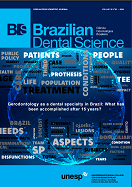Effects of different polishing systems on the surface roughness of two ceromers
DOI:
https://doi.org/10.14295/bds.2016.v19i2.1241Abstract
Objective: This in vitro study evaluated the effects of three polishing systems on the surface roughness of two ceromers. Material and Methods: 96 specimens (8 mm in diameter and 2 mm thick) were prepared in a metal mold using two restorative materials: CERAMAGE (Shofu, Japan) and VMLC VITA (VITA Zahnfabrik, Germany). The specimens were divided into 4 groups (n=12): G1: positive control, Mylar strip; G2: abrasive tips, Edenta system; G3: silicon tips, Enhance system; and G4: abrasive tips, Shofu system. The parameter evaluated was the average surface roughness (Ra) determined by using a profilometer SJ 301 (Mitutoyo, Japan), followed by photographic evaluation images through Scanning Electron Microscopy (SEM), with a 1000x magnification range. The data was subjected to statistical analysis for comparison between the groups (ANOVA, Tukey and Student T-tests), with a significance level of 5%. Results: there was a statistically significant difference between the silicone tip Enhance and the other groups for both ceromers with higher values of surface roughness. There was no statistically significant difference between the ceromers, except for the Shofu system, which showed lower values of surface roughness for Vita VMLC. Conclusion: Within the limitations of this study, it was concluded that the Edenta and Shofu abrasive tips are more effective in reducing the surface roughness of ceromers compared with the Enhance silicone tip.
Keywords: Resins; Surface roughness; Dental polishing.
Downloads
Downloads
Published
How to Cite
Issue
Section
License
Brazilian Dental Science uses the Creative Commons (CC-BY 4.0) license, thus preserving the integrity of articles in an open access environment. The journal allows the author to retain publishing rights without restrictions.
=================




























